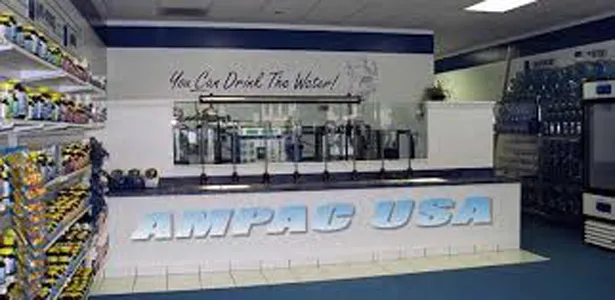When it comes to ensuring clean, safe drinking water, one of the most essential tools in your water quality arsenal is the TDS meter for water testing. Whether you’re using a reverse osmosis system, managing an industrial setup, or simply checking your home water supply, a TDS meter offers quick and effective insight into what’s in your water. At AMPAC USA, we emphasize accurate water quality monitoring—and understanding TDS (Total Dissolved Solids) is a key part of that mission.
What Is a TDS Meter for Water Testing?
A TDS meter for water testing is a handheld device used to measure the total amount of dissolved solids in a water sample. These solids can include minerals, salts, metals, and organic matter. The reading is typically expressed in parts per million (ppm), indicating how many milligrams of dissolved solids are present in one liter of water.
At AMPAC USA, we offer a range of advanced water treatment systems, and we always recommend using a TDS meter to ensure optimal system performance, especially in reverse osmosis applications.
Why Is TDS Important in Water Testing?
TDS is a crucial indicator of water purity. High TDS levels can signal contamination, hard water, or system malfunction. Conversely, very low TDS could suggest water has been over-purified and may lack essential minerals. Here are key reasons why monitoring TDS matters:
-
Health concerns: High TDS may indicate harmful substances like lead or arsenic.
-
Taste and odor: Elevated TDS affects the taste and smell of water.
-
System performance: For RO systems, high input TDS can damage membranes.
-
Industrial processes: In manufacturing or labs, TDS affects chemical reactions and product quality.
At AMPAC USA, we integrate TDS monitoring into many of our water purification solutions to ensure consistent, reliable water quality.
How Does a TDS Meter for Water Testing Work?
TDS meters operate using electrical conductivity. Dissolved solids in water conduct electricity, so by measuring the conductivity, the meter estimates the concentration of dissolved substances. The process includes:
-
Dip the probe into the water sample.
-
Read the display, which shows TDS in ppm.
-
Interpret the result based on acceptable TDS levels for your application.
At AMPAC USA, our experts help clients calibrate and use their TDS meters for water testing to achieve accurate results, whether in residential, commercial, or industrial environments.
Ideal TDS Levels in Drinking Water
According to the EPA and WHO guidelines, acceptable TDS levels for drinking water are:
| TDS Level (ppm) | Water Quality |
|---|---|
| 0 – 50 | Ideal for RO water |
| 50 – 150 | Excellent |
| 150 – 300 | Good |
| 300 – 500 | Fair (acceptable limit) |
| 500+ | Poor (Not recommended) |
While AMPAC USA’s reverse osmosis systems aim to reduce TDS to ideal levels (under 100 ppm), it’s important not to remove all minerals unless required for specific applications like pharmaceutical processing or laboratory testing.
Applications of TDS Meter for Water Testing
The use of a TDS meter for water testing spans across multiple domains:
1. Residential Use
Homeowners use TDS meters to:
-
Monitor drinking water quality
-
Verify RO system effectiveness
-
Test tap or well water for safety
2. Commercial Use
Businesses such as:
-
Bottled water companies
-
Restaurants
-
Spas and salons
routinely use TDS meters to maintain compliance and customer satisfaction.
3. Industrial Use
In manufacturing, pharmaceuticals, power plants, and electronics:
-
TDS impacts cooling processes, chemical formulations, and equipment performance.
-
AMPAC USA integrates TDS meters into industrial RO and water purification setups.
4. Aquariums & Hydroponics
TDS levels affect fish health and plant growth. Accurate monitoring is essential for aquatic life and nutrient-rich water for crops.
How to Choose the Best TDS Meter for Water Testing
At AMPAC USA, we help our clients choose the right TDS meter based on their specific needs. Here’s what to look for:
Accuracy & Calibration
A good TDS meter should offer ±2% accuracy and allow manual or automatic calibration for precise results.
Display and Readability
Look for models with digital backlit screens, ideal for both indoor and field testing.
Temperature Compensation
Some TDS meters have automatic temperature compensation (ATC), ensuring consistent readings despite temperature variations.
Durability
For industrial and outdoor use, opt for water-resistant and rugged designs.
Range
Ensure the meter covers the range relevant to your application (typically 0–9999 ppm).
AMPAC USA recommends high-accuracy models with ATC and multi-functional features to get the most reliable data.
Using a TDS Meter for Water Testing: Step-by-Step
-
Turn on the meter.
-
Rinse the probe with distilled water to avoid contamination.
-
Immerse it in the sample up to the marked level.
-
Wait for the stable reading (usually a few seconds).
-
Record the result.
-
Rinse and store properly after use.
Routine testing is vital. We recommend checking RO system performance weekly using a TDS meter for water testing, especially in high TDS regions.
Benefits of Using a TDS Meter from AMPAC USA
AMPAC USA not only delivers advanced reverse osmosis systems but also provides premium-grade TDS meters and expert consultation. Here’s what sets us apart:
-
Accuracy & Quality: We offer industry-trusted brands with high calibration precision.
-
Expert Guidance: Our team educates clients on interpreting results for better water decisions.
-
Integration Support: We help you embed TDS monitoring into your treatment systems.
-
After-Sales Support: Get assistance with calibration, usage, and troubleshooting.
When Should You Replace Your TDS Meter?
Like any electronic device, a TDS meter can degrade over time. Replace your meter or its probe if:
-
It fails to calibrate properly.
-
Readings become erratic.
-
The display malfunctions.
-
It’s been physically damaged or corroded.
AMPAC USA provides reliable replacements and parts to ensure uninterrupted monitoring.
TDS Meter for Water Testing and Reverse Osmosis Systems
If you’re using a reverse osmosis system from AMPAC USA, a TDS meter becomes indispensable. Here’s how:
-
Feed Water Monitoring: Test incoming water to prevent premature RO membrane failure.
-
Product Water Monitoring: Verify if the purified water meets the expected TDS target.
-
Maintenance Planning: Sudden TDS spikes could signal membrane clogging or filter issues.
We design systems with in-line TDS meters for real-time monitoring or offer portable handheld options for flexibility.
Conclusion: Invest in a TDS Meter for Accurate Water Testing
A TDS meter for water testing is not just a convenience—it’s a necessity for anyone serious about water quality. Whether for your home, business, or industrial plant, it empowers you to make informed decisions and maintain safe, healthy water. At AMPAC USA, we combine cutting-edge purification technology with dependable TDS monitoring tools to ensure every drop you drink is of the highest quality.
Recommended TDS Meters and Reverse Osmosis Systems at AMPAC USA
Here are some top solutions available at AMPAC1.com:
✅ AMPAC USA Portable TDS Meter
-
Accurate readings up to 9999 ppm
-
Auto temperature compensation
-
Pocket-size, rugged design
-
Ideal for field and household use
✅ Wall-Mounted Reverse Osmosis System with TDS Monitoring
-
Integrated TDS sensor
-
1000 GPD RO capacity
-
Easy maintenance
-
Designed for light commercial & industrial applications
✅ Seawater Desalination Units with TDS Feedback
-
Real-time monitoring
-
Suitable for coastal & marine installations
-
Auto-shutoff on high TDS alarms
To explore our full range of TDS meters for water testing and custom water treatment solutions, visit www.ampac1.com or contact our expert team today.












Букеты из тюльпанов на 8 марта — это идеальный способ выразить свои чувства и сделать этот день незабываемым. [url=https://cvety8marta.ru/]Тюльпаны на 8 марта заказать[/url].
Композиции из тюльпанов на Международный женский день — это отличный способ выразить свою любовь и уважение к женщинам. Некоторые женщины предпочитают классические красные или розовые тюльпаны, а другие любят более яркие и необычные оттенки.
https://t.me/s/Officiall_Telegram_1win
Приветствую всех форумчан! Хочу поделиться своим опытом использования топливных карт. Возможно, кому-то мой отзыв окажется полезным.
Раньше, как и многие, я тратил уйму времени на сбор чеков, составление отчетов и постоянные подсчеты. Бензин то дорожал, то дешевел, а бухгалтер, мягко говоря, не был в восторге от кипы бумажек, которые я приносил.- [url=https://vybratauto.ru/]топливные карты[/url]